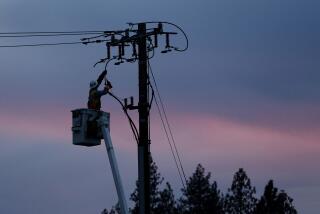Renewable energy ‘on’ switch
California is blessed with renewable energy resources that it has barely begun to harvest, an enlightened electorate that understands the importance of doing so and a venture-capital community eager to make green investments. In fact, the state has everything it needs to lead the world in clean energy development, except for one thing: a functional government.
The Legislature isn’t just bad at passing budgets; it’s bad at moving major legislation even when it’s favored by a strong majority of lawmakers and the public. That’s why the state still doesn’t have a renewable energy standard even though a sensible bill to establish one has been taken up annually since 2007. The bill was actually passed by both houses in 2009 but was vetoed by then-Gov. Arnold Schwarzenegger, and last year it languished as lawmakers bickering about less important issues allowed time to expire on the 2010 session.
Now it’s back, and just as we have done every year for the last four years, we’re once again hoping the political establishment can overcome its legacy of failure and give California an early lead in the struggle to wean the nation off of fossil fuels, clean the state’s air, boost its fledgling green industries and set an example on responsible mitigation strategies for climate change. SBX1 2 from Sen. Joe Simitian (D-Palo Alto) is scheduled for a vote in the state Senate on Thursday. It would mandate that utilities derive 33% of their power from renewable sources, such as the sun, wind or underground heat, by 2020.
Schwarzenegger vetoed the bill in 2009 because he objected to some technical details of that version, particularly provisions dictating the amount of renewable power that could be generated out of state. Many of his concerns have been addressed in the new legislation. And although Schwarzenegger issued an executive order to establish the 33% standard after the veto, it’s very important for the standard to take the form of legislation rather than a gubernatorial order, because the latter can be changed at whim by any new administration. Without the force of law, utilities and investors lack the certainty they need to proceed with new renewable projects.
Nowhere is that lack of certainty having a more destructive impact than in Los Angeles, where the Department of Water and Power has been stalled by political turmoil over rate hikes and the influence of a powerful labor union determined to block clean energy projects unless they’re owned by the utility and thus staffed and built by union workers. Without a strong state mandate, the DWP will remain reliant on power plants fueled by coal and natural gas, making a mockery of Mayor Antonio Villaraigosa’s promises to make L.A. the “greenest big city in America.”
More to Read
A cure for the common opinion
Get thought-provoking perspectives with our weekly newsletter.
You may occasionally receive promotional content from the Los Angeles Times.










